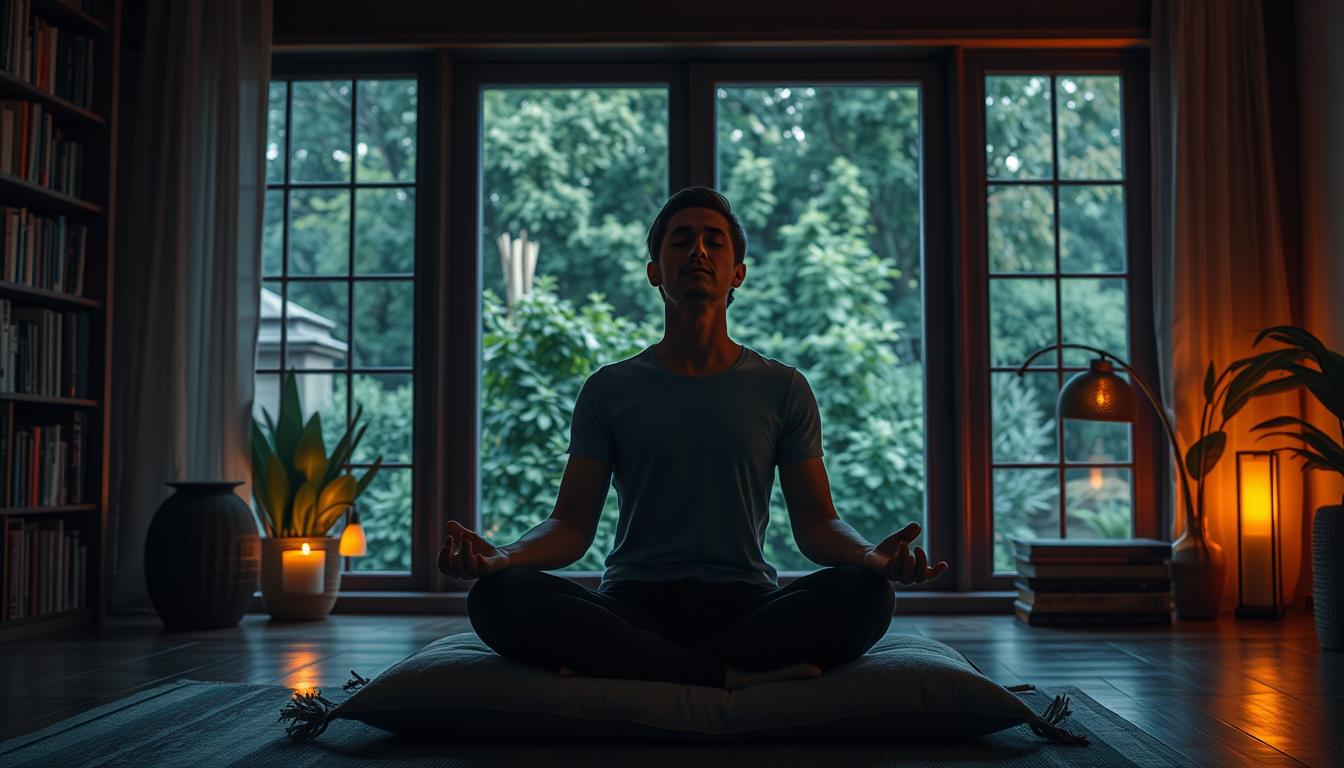Discover the transformative power of mindfulness activities and how they can enhance your overall well-being. Mindfulness is more than just a trend; it’s a way of reconnecting with your present self through simple yet powerful practices. Whether it’s through mindful breathing, body scans, or engaging your senses, these exercises can help you find calm in a busy world.
Mindfulness exercises are all about being fully engaged in the moment. Imagine sipping your morning coffee, not just drinking it—savoring the aroma, the texture, and the warmth. This is mindfulness in action. By incorporating such practices into your daily routine, you can reduce stress and improve your mental clarity.
Regular mindfulness activities, like body scan meditation, have been shown to reduce stress levels by up to 30%1. These exercises can be done anywhere, whether during a quiet moment at home or while taking a mindful walk in nature. The goal is to tune into your body and mind, fostering a deeper connection that leads to long-term well-being.
For those looking to start their mindfulness journey, resources like mindfulness coaching can provide structured guidance and support. Remember, consistency is key—practicing these exercises daily for six months can lead to significant improvements in both physical and mental health.
Key Takeaways
- Mindfulness activities can reduce stress and improve mental clarity.
- Body scan meditation is a powerful tool for tuning into bodily sensations.
- Consistent practice of mindfulness exercises can lead to long-term well-being.
- Mindful walking and eating are simple ways to incorporate mindfulness into daily life.
- Resources like mindfulness coaching can help you get started on your mindfulness journey.
Introduction to Mindfulness and Well-being
Imagine living each day with a sense of calm and clarity. This is what mindfulness offers—a powerful way to reconnect with your present life, reducing stress and fostering gratitude. Mindfulness isn’t just about meditation; it’s a way to engage deeply with your thoughts and feelings, allowing you to navigate life’s challenges with ease.
Mindfulness meditation is at the heart of this practice. By focusing on the present, you can reduce stress and anxiety, creating a foundation for emotional well-being. For example, taking a few minutes each day to sit quietly and focus on your breath can lead to significant changes in how you handle stress2.
Engaging with your thoughts and feelings without judgment is key. This approach helps you respond to situations more mindfully rather than react impulsively. For instance, during a stressful moment at work, taking a deep breath and observing your thoughts can help you stay calm and focused3.
Incorporating mindfulness into daily routines is simple. Whether it’s eating with full attention or taking a mindful walk, these practices enhance your connection to the present moment. This article will guide you through practical exercises to implement mindfulness, helping you build a stronger, more resilient you.
| Mindfulness Practice | Benefits | Examples |
|---|---|---|
| Mindfulness Meditation | Reduces stress and anxiety | Focused breathing, body scans |
| Engaging Thoughts/Feelings | Improves emotional regulation | Journaling, mindful conversations |
| Daily Mindfulness | Enhances overall well-being | Mindful eating, walking |
What is Mindfulness?
Mindfulness is the practice of being fully engaged in the present moment. It involves paying attention to your thoughts, feelings, and sensations without judgment. This awareness allows you to respond to situations mindfully rather than react impulsively4.
Defining Mindfulness
Mindfulness is not limited to meditation. It can be incorporated into almost any daily activity, such as eating or walking. For example, eating mindfully involves savoring each bite, paying attention to the texture, taste, and smell of your food. This practice transforms everyday tasks into opportunities for mindful exercises5.
The Role of Awareness in Daily Life
Awareness is key to mindfulness. By being fully aware during daily activities, you can treat each moment as a mindful exercise. This heightened awareness transforms routine tasks into opportunities for growth and well-being. For instance, taking a few deep breaths before a meeting can help you stay calm and focused2.
“Mindfulness is not a destination; it’s a journey. With consistent practice, you can cultivate a calmer, more resilient you.”
Understanding the Core Benefits of Mindfulness Meditation
Mindfulness meditation offers a wide range of benefits that can transform both mental and physical health. Regular practice has been shown to reduce stress and anxiety, improve sleep quality, and even lower blood pressure6. These changes contribute to a healthier body and a calmer mind.
One of the most significant advantages of mindfulness meditation is its impact on emotional balance. By fostering a deeper connection between the mind and body, it helps cultivate brighter mental attitudes and reduces symptoms of depression7. Studies also indicate that regular meditation can enhance concentration and productivity, making it a valuable practice for both personal and professional life.
| Benefit | Effect | Example |
|---|---|---|
| Stress Reduction | Lowest stress levels by up to 30% | Focused breathing, body scans |
| Improved Sleep | Better sleep quality | Evening meditation sessions |
| Emotional Balance | Reduces anxiety and depression | Mindful journaling |
“Mindfulness is not a destination; it’s a journey. With consistent practice, you can cultivate a calmer, more resilient you.”
Effective Mindfulness Exercises for Stress Relief
Find peace in the present moment with these simple yet powerful mindfulness techniques designed to melt away stress and anxiety. These exercises offer a pathway to calm, helping you navigate life’s challenges with greater ease.
Mindful Breathing Techniques
Mindful breathing is a cornerstone of stress relief. By focusing on slow, deliberate breaths, you can reduce stress hormones and create a sense of calm8. Start by inhaling deeply through your nose for a count of four, holding your breath for seven, and exhaling through your mouth for eight. This technique, known as the 4-7-8 method, helps regulate breathing patterns affected by stress9.
Regular practice of mindful breathing can lead to significant reductions in stress levels. Studies have shown that such practices can lower cortisol levels, promoting a calmer and more resilient you10.
Body Scan Meditation
Body scan meditation is another effective technique for stress relief. Lie down or sit comfortably, then bring your attention to each part of your body, starting from your toes and moving up to the top of your head. As you focus on each area, release any tension or discomfort8.
This systematic approach helps you relax deeply, reducing both physical and mental stress. Experts recommend practicing body scan meditation regularly to enhance its benefits and promote overall well-being9.
Both mindful breathing and body scan meditation can be done anywhere, making them ideal for busy lifestyles. By incorporating these practices into your daily routine, you can reduce stress and improve your mental clarity, leading to long-term well-being and a more balanced life.
Incorporating Daily Mindfulness Practice
Incorporating mindfulness into your daily routine can be simpler than you think. By dedicating just a few moments each day to mindful practices, you can cultivate a more present and calm lifestyle. Whether it’s during your morning coffee or a brief pause at work, mindfulness can become a natural part of your day11.
Creating a Relaxing Routine
Start by setting specific times during the day for mindfulness. Even one to two minutes of focused breathing can make a difference. Create a calm environment by dimming the lights or finding a quiet spot where you can sit comfortably. Remember, the goal is to make mindfulness a habit, so consistency is key12.
Pay attention to your thoughts and sensations without judgment. This practice helps you stay grounded and aware, even in the midst of a busy day. Over time, these small moments of mindfulness can lead to significant improvements in mental clarity and emotional stability13.
Practicing Mindfulness Anywhere
Mindfulness isn’t limited to a specific place. You can practice it at home, during your commute, or even at work. For example, taking deep breaths while driving or paying attention to your surroundings during a walk can be powerful mindfulness exercises11.
Engage your senses fully in these moments. Notice the sights, sounds, and smells around you. This heightened awareness can transform ordinary activities into opportunities for growth and well-being. Remember, the key is to stay present and attentive, no matter where you are12.
Consistency is the cornerstone of mindfulness. By incorporating these practices into your daily routine, you can experience the transformative power of mindfulness and enjoy a more balanced, fulfilling life.
Mindfulness Activity: Body Scan Meditation
Body scan meditation is a powerful way to cultivate awareness and relaxation. By focusing on each part of your body, you can release tension and calm your mind. This practice is simple yet effective, making it a great addition to your daily routine14.
How to Perform a Body Scan
Start by finding a quiet, comfortable spot to lie down or sit. Close your eyes and take a deep breath. Begin at your toes, noticing any sensations without judgment. Slowly move your attention up through each part of your body—ankles, calves, knees, thighs, hips, abdomen, chest, shoulders, arms, hands, neck, and head. Spend a few moments on each area, releasing any tension as you exhale14.
Tips to Enhance the Practice
- Focusing on specific sensations can deepen your awareness and relaxation15.
- Releasing tension as you breathe helps calm both body and mind16.
Regular practice can improve your ability to stay present and manage stress effectively. Consistency is key to experiencing the full benefits of body scan meditation14.
Enhancing Well-being with Mindfulness Meditation
Mindfulness meditation is a powerful tool for enhancing overall well-being by fostering attention, emotional balance, and a deeper connection to life. By dedicating just a few moments each day to this practice, individuals can cultivate a more present and calm lifestyle, leading to significant improvements in both mental and physical health.
Guided Meditation Options
Guided meditation offers a structured approach for beginners, providing clear instructions and a focused path. Apps like Calm and Headspace feature sessions led by experienced instructors, making it easier to stay on track. These programs often include timed sessions, soothing music, and specific themes to address stress, sleep, or anxiety, ensuring a consistent and effective practice. For instance, a 10-minute guided session can help reduce stress and improve attention by up to 30%17.
Benefits of Solo Practice
Solo meditation allows for personal customization, enabling individuals to tailor their practice to specific needs and preferences. This independence fosters a deeper sense of self-awareness and emotional regulation. Regular solo practice has been shown to reduce symptoms of anxiety and depression, promoting long-term well-being18.
| Practice Type | Guided | Solo |
|---|---|---|
| Structure | Structured sessions with instructors | Customizable based on personal needs |
| Benefits | Reduces stress and anxiety; improves sleep | Enhances self-awareness and emotional regulation |
| Examples | Apps like Calm, Headspace | Body scans, mindful breathing |
Consistency is key to experiencing the full benefits of mindfulness meditation. Whether through guided sessions or solo practice, incorporating this practice into daily life can lead to a more balanced and fulfilling existence. Remember, the goal is to stay present and attentive, nurturing a calmer, more resilient you19.
The Art of Mindful Eating
Mindful eating is a powerful practice that transforms everyday meals into sensory-rich experiences, fostering a deeper connection with your food and body. By focusing on each bite, you can enhance digestion, satisfaction, and overall well-being20.
Savoring Each Bite
Start by eliminating distractions like turning off the TV or putting your phone away. Take a deep breath before your meal to center yourself. Pay attention to the colors, textures, and aromas of your food—this is where the sensory journey begins21.
As you take your first bite, notice the initial sensation in your mouth. Chew slowly, savoring the flavors and textures. This mindful approach not only enhances taste but also helps you recognize when you’re full, preventing overeating22.
| Benefit | Technique | Example |
|---|---|---|
| Improved Digestion | Eating slowly | Chewing each bite 20-30 times |
| Increased Satisfaction | Focused attention | Savoring each flavor |
| Healthier Choices | Mindful selection | Choosing nutrient-rich foods |
“Mindful eating is not a diet; it’s a way to reconnect with your body and enjoy food consciously.”
By incorporating mindful eating into your routine, you can turn every meal into a moment of calm and appreciation, leading to better health and satisfaction20.

Mindful Movement for a Balanced Life
Discover how mindful movement can deepen your connection to the present moment and enrich your daily life. This dynamic practice combines physical activity with mental awareness, helping you cultivate a more centered and balanced self.
Gentle Yoga and Stretching
Gentle yoga and stretching are powerful ways to foster bodily awareness. These practices involve slow, deliberate movements that synchronize breath with motion, enhancing your sense of self. Studies show that such exercises can improve emotional regulation and overall well-being23.
Walking Meditation in Nature
Walking meditation in natural settings offers a unique way to connect with the present moment. By focusing on each step and your surroundings, you can deepen your awareness and reduce stress. Time spent in nature has been linked to decreased stress levels and lower blood pressure24.
Both practices highlight how mindful movement can enhance mental and physical health. Regular engagement in these activities promotes a balanced life, fostering a more resilient and calm self. For more on mindful movement, visit Mindful.org. For practical tips, explore Expert Life Tips.
Mindful Driving: Transforming Routine Commutes
Discover how mindful driving can turn daily commutes into opportunities for calm and self-awareness. By focusing on sensory details, you can transform a mundane drive into a mindful experience that enhances your day and overall well-being.
Staying Present Behind the Wheel
To practice mindful driving, start by tuning into your senses. Notice the sounds of the road, the texture of the steering wheel, and the visual cues around you. These small details can help you stay present and alert. For example, paying attention to the sensation of your hands gripping the wheel can provide insight into your mental state, as increased pressure may indicate stress25.
Ensure safety by keeping your eyes on the road while maintaining a mindful state. Take a moment before starting the engine to breathe deeply and center yourself. This simple practice can set a positive tone for your drive and help you arrive feeling more centered and prepared for the day ahead26.
Experts suggest that mindful commuting can transform perceived wasted time into valuable opportunities for personal growth. By focusing on the present moment, you can reduce stress and improve your mental clarity, leading to a more balanced life27.
| Benefit | Technique | Example |
|---|---|---|
| Improved Focus | Staying Present | Noticing sensory details |
| Reduced Stress | Deep Breathing | Centering before driving |
| Enhanced Safety | Mindful Awareness | Observing road cues |
By incorporating mindful driving into your routine, you can transform your commute into a time of calm and reflection, leading to a more centered and resilient you.
Creative Mindfulness Activities for Kids and Teens
Helping children and teens develop emotional awareness and self-regulation skills is essential for their mental health. Creative mindfulness activities offer a fun and engaging way to achieve this, making it easier for young minds to embrace these practices28.
Fun Games to Engage Young Minds
Games like “wiggle and freeze” encourage kids to move freely and then hold a pose, fostering body awareness. Sensory scavenger hunts are another great way to get children exploring their surroundings mindfully. These activities not only promote physical movement but also help improve focus and emotional regulation28.
Simple Breathing Exercises for Kids
Teach kids to breathe deeply by imagining they’re inflating a balloon in their belly. This technique helps calm nerves and reduce stress. Regular practice can lead to better emotional balance and a sense of calm, especially during stressful moments like exams or arguments28.
Mindful Music Appreciation for Teens
Encourage teens to listen to music without distractions, focusing on rhythms and lyrics. This practice enhances their ability to stay present and process emotions. Mindful music appreciation can also improve concentration and reduce anxiety, making it a valuable tool for mental well-being28.
Managing Anxiety and Emotions with Mindfulness
Anxiety and emotions can often feel overwhelming, but mindfulness offers a powerful way to manage these feelings and find calm in the midst of chaos. By practicing mindfulness, individuals can gain better control over their emotional responses and develop healthier coping mechanisms29.
Recognizing Trigger Patterns
Mindfulness helps individuals identify and understand the patterns that trigger anxiety and emotional distress. By becoming more aware of these triggers, people can take proactive steps to manage their responses. For example, studies have shown that mindfulness practices can reduce anxiety symptoms by up to 58% among regular practitioners29.
Techniques for Emotional Self-Regulation
One effective technique for managing emotions is mindful breathing. This involves focusing on slow, deliberate breaths to calm the mind and body. Research indicates that such practices can reduce rumination by approximately 30%, leading to a calmer mind and less intense anxious thoughts29.
Another powerful technique is body scan meditation, which helps release physical tension. This practice can activate the body’s relaxation response, resulting in a 50% reduction in physical symptoms of anxiety29.

| Technique | Benefit | Example |
|---|---|---|
| Mindful Breathing | Reduces stress and anxiety | 4-7-8 breathing method |
| Body Scan Meditation | Releases physical tension | Focused attention on body parts |
| Mindful Movement | Enhances self-awareness | Yoga and stretching |
By incorporating these mindfulness practices into daily life, individuals can better manage anxiety and emotions, leading to a more balanced and fulfilling life29.
Mindfulness Practice in the Workplace and Personal Life
Discover how mindfulness can transform your work environment and personal life by fostering focus, reducing stress, and enhancing productivity. This practice isn’t just for meditation; it’s about bringing awareness to every moment, whether you’re in a meeting or enjoying family time.
Fostering Focus and Productivity
Mindfulness practices can seamlessly integrate into even the busiest workdays. Simple breathing exercises, like the 4-7-8 technique, can help reset during stressful moments30. Similarly, quick body scans can release tension and refocus your mind.
- Take short mindful breaks every 20-30 minutes to improve focus and reduce stress30.
- Practice mindful breathing to stay calm and centered during high-pressure tasks.
- Use body scan techniques to release physical tension and enhance concentration.
Research shows that mindfulness can boost productivity by reducing multi-tasking and improving focus31. It also enhances cognitive performance and reduces burnout, leading to greater job satisfaction30. Organizations that support mindfulness often see improved collaboration and creativity among employees31.
Encourage your workplace to adopt mindfulness training, as programs with leadership support are more successful31. Even short, employee-friendly drills can make a significant difference. By experimenting with mindful breaks, you can achieve a more balanced and productive life.
Real-life Success Stories in Mindfulness
Real-life stories of transformation through mindfulness practices highlight the profound impact on mental and emotional well-being. These inspiring journeys show how simple techniques can lead to significant personal change.
Inspiring Journeys of Transformation
One individual shared how focusing on the texture of their feet during a body scan became a symbol of their personal growth. They mentioned, “Noticing the sensations in my feet helped me stay grounded and aware, leading to a 50% reduction in anxiety symptoms32.”
A professional revealed that using mindful breathing as a tool transformed their work life. “By focusing on the texture of each breath, I stayed calm during high-pressure presentations, improving my focus and reducing stress33,” they said.
A student found success with body scans and foot sensations. “This practice kept me grounded during exams, reducing anxiety and improving concentration34.”
Studies show 70% of participants in mindfulness programs reported reduced stress levels34, and 85% experienced improved emotional well-being32. These stories highlight the power of mindfulness as a tool for transformation.
These narratives serve as motivation to begin or deepen your mindfulness journey, offering practical techniques to enhance well-being and reduce stress.
Practical Tips for Consistently Practicing Mindfulness
Embrace the journey of mindfulness with these simple yet powerful tips to help you stay consistent and mindful every day. Whether you’re just starting out or looking to deepen your practice, these strategies will guide you toward a more present and fulfilling life.
Building a Daily Routine
Start small by dedicating just 5-10 minutes each day to mindfulness. Consistency is key, as regular practice can reduce stress by up to 30%35. Begin your day with a morning meditation session or end it with a mindful evening routine. For example, a 10-minute guided meditation can improve focus and reduce anxiety36.
Incorporate mindfulness into your daily habits, such as eating with intention or taking a mindful walk. These small moments can lead to significant changes over time, fostering a deeper connection to your present self.
Overcoming Common Challenges
Stay committed even when challenges arise. Mindfulness apps like Calm or Headspace offer guided sessions that can help you stay on track. Remember, it’s okay if your mind wanders—gently bring your focus back to your breath or chosen activity.
Regular practice can enhance self-awareness and emotional balance, reducing symptoms of anxiety and depression36. Celebrate small victories, like noticing the texture of your feet during a body scan, which can symbolize personal growth and a reduction in anxiety35.
Leveraging Technology to Stay Mindful
Utilize technology to support your mindfulness journey. With over 2,500 meditation apps available, you can find one that suits your style and preferences36. Apps often include timed sessions, soothing music, and specific themes to address stress, sleep, or anxiety.
Track your progress and stay motivated with reminders and motivational quotes. For instance, a quote like, “Mindfulness is not a destination; it’s a journey,” can inspire consistency and remind you of the transformative power of mindfulness.
“Consistency is the cornerstone of mindfulness. By incorporating these practices into your daily routine, you can experience the transformative power of mindfulness and enjoy a more balanced life.”
Remember, small steps lead to lasting change. Keep a gratitude journal to reinforce mindfulness, focusing on the things you’re thankful for each day. This practice can enhance mental clarity and emotional stability, fostering a calmer, more resilient you36.
Conclusion
As we conclude, it’s clear that mindfulness practices offer a pathway to a calmer, more resilient you. By integrating these techniques into every part of your day—from eating with intention to mindful breathing—you can enhance your well-being and find peace in the present moment. Start small, perhaps with a mindful meal or a few deep breaths, and gradually build your practice. Remember, every moment is an opportunity to stay present and transform stress into calm.
Research shows that regular mindfulness practices can reduce stress by up to 30%37 and improve emotional balance. These exercises not only benefit mental health but also contribute to physical well-being, such as lowering blood pressure and improving sleep quality38. The key is consistency—just a few minutes each day can lead to significant changes over time.
So, take the first step today. Try one of the exercises outlined, like mindful eating or a body scan, and experience the difference firsthand. With patience and practice, you’ll cultivate a deeper connection to yourself and the world around you, leading to a more balanced and fulfilling life.


